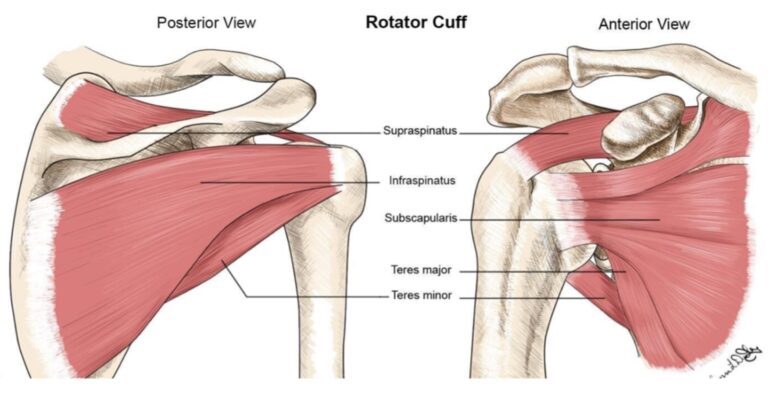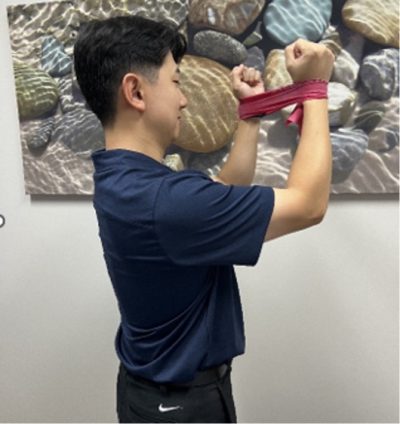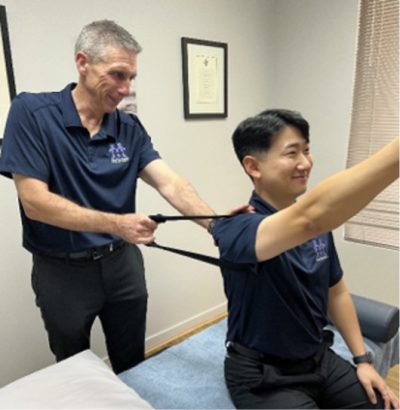Understanding Rotator Cuff-Related Shoulder Pain
Are you experiencing shoulder pain? Has anyone told you that it is a ROTER CUFF issue?
The actual name is ROTATOR CUFF!
Shoulder pain is one of the most common musculoskeletal complaints, and rotator cuff-related shoulder pain is a frequent cause of discomfort and limited function. The rotator cuff is a group of four muscles and their tendons that stabilise the shoulder joint and facilitate movement.
Injuries or degeneration of these muscles or tendons can lead to pain, weakness, and restricted mobility.

The rotator cuff stabilises the shoulder joint and enables smooth movement. These rotator cuff muscles are the supraspinatus, infraspinatus, teres minor, and subscapularis, each with a specific function:
- Supraspinatus: Assists in initiating shoulder abduction.
- Infraspinatus: Primarily responsible for external rotation.
- Teres minor: Supports external rotation and joint stability.
- Subscapularis: Facilitates internal rotation and anterior shoulder stability.
These muscles help maintain the humeral head’s (top of the upper arm bone) position within the glenoid (shoulder socket), ensuring controlled and coordinated shoulder movements.
Muscle function is essential for overhead tasks, lifting, and throwing motions. Weakness or dysfunction, often caused by overuse, poor mechanics, or degenerative changes, can lead to pain and reduced function, as seen in rotator cuff tendinopathy or tears. Targeted strengthening and mobility exercises are key for both rehabilitation and injury prevention.
Causes of Rotator Cuff-Related Shoulder Pain
Rotator cuff pain can develop due to several factors, including:
- Overuse and Repetitive Movements: Activities that involve repetitive overhead motions, such as swimming, weightlifting, or painting, can strain the rotator cuff muscles over time.
- Aging and Degeneration: As we age, the tendons of the rotator cuff can weaken, leading to degeneration and potential tears.
- Acute Injury: A fall, lifting a heavy object, or sudden impact can cause a partial or full-thickness tear of the rotator cuff tendons.
- Postural: Posture can increase stress on the rotator cuff.
Symptoms of Rotator Cuff Related Shoulder Pain
The symptoms of rotator cuff-related shoulder pain can range from mild discomfort to severe impairment. Common signs and symptoms include:
- Pain at Rest and During Movement: Pain is often felt in the front or side of the shoulder and can radiate down the arm.
- Weakness in the Shoulder: Difficulty lifting objects or performing overhead activities is a common complaint.
- Limited Range of Motion: Stiffness and difficulty raising the arm above shoulder height may occur.
- Pain When Lying on the Affected Shoulder: Many individuals experience increased discomfort at night, which can disrupt sleep.
Treatment and Rehabilitation
Managing rotator cuff-related shoulder pain typically involves a combination of physiotherapy, lifestyle modifications, and in some cases, medical interventions.
Physiotherapy and Exercise
Physiotherapy plays a crucial role in treating rotator cuff-related shoulder pain. A tailored rehabilitation program includes:
- Strengthening Exercises: Targeting the rotator cuff muscles and surrounding stabilisers helps restore function and prevent further injury.
- Motor Control Exercises: Specific muscle control and/or coordination, dynamic muscular stabilisation, proprioceptive exercises, or movement control exercises.
Shoulder Flexion with External Rotation using an exercise band
- Scapula-focused exercises: Focused on scapular muscles and/or aimed at increasing scapular postural awareness and/or stability.
- Symptom modification treatment: Identifying and modifying individual symptoms to improve function and/or reduce pain.

Glenoid Humeral Joint glide and/or Upward rotation
- Stretching and Mobility Work: Gentle stretching improves flexibility and reduces stiffness in the shoulder.
- Postural Correction: Addressing posture-related issues through ergonomic adjustments and specific exercises can alleviate strain on the shoulder.
- Manual Therapy: Hands-on techniques such as soft tissue massage and joint mobilisations can relieve pain and improve movement.
Other Treatment Approaches
- Pain Management: Nonsteroidal anti-inflammatory drugs (NSAIDs) and ice therapy can help manage pain and inflammation.
- Activity Modification: Avoiding aggravating movements and gradually returning to activities can prevent further damage.
- Corticosteroid Injections: In cases of persistent pain, injections may provide temporary relief.
- Surgical Intervention: If conservative treatments fail and the tear is severe, surgical repair may be necessary.

Preventing Rotator Cuff Injuries
Prevention strategies include maintaining strong and flexible shoulder muscles, practising good posture, and avoiding excessive overhead activities. Regular physiotherapy check-ups can help identify potential issues before they lead to chronic pain.
If you’re experiencing persistent shoulder pain or acute shoulder pain, consulting a physiotherapist can help you develop a personalised recovery plan and prevent further complications.
Addressing shoulder pain early can ensure a faster and more effective recovery, allowing you to return to your daily activities pain-free as early as possible.
Author: Charlie Shin, Physiotherapist, Health on Grange Physiotherapy
References:
Lafrance, S., Charron, M., Dubé, M. O., Desmeules, F., Roy, J. S., Juul-Kristensen, B., … & McCreesh, K. (2024). The efficacy of exercise therapy for rotator cuff related shoulder pain according to the FITT principle: a systematic review with meta-analyses. Journal of Orthopaedic & Sports Physical Therapy, 54(8), 1-26.
Lewis, J., McCreesh, K., Roy, J. S., & Ginn, K. (2015). Rotator cuff tendinopathy: navigating the diagnosis-management conundrum. Journal of orthopaedic & sports physical therapy, 45(11), 923-937.
Lewis, J. (2016). Rotator cuff related shoulder pain: assessment, management and uncertainties. Manual therapy, 23, 57-68.
